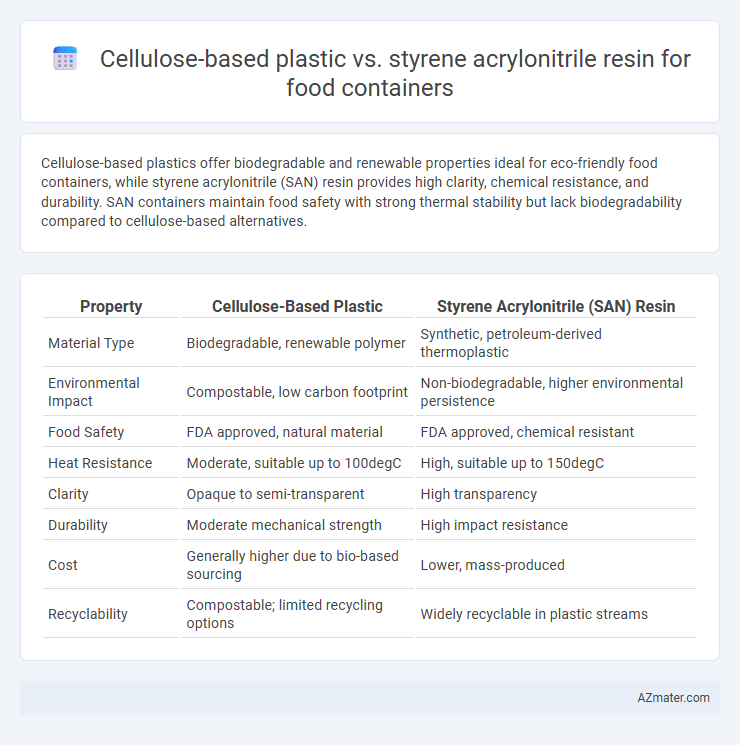Cellulose-based plastics offer biodegradable and renewable properties ideal for eco-friendly food containers, while styrene acrylonitrile (SAN) resin provides high clarity, chemical resistance, and durability. SAN containers maintain food safety with strong thermal stability but lack biodegradability compared to cellulose-based alternatives.
Table of Comparison
| Property | Cellulose-Based Plastic | Styrene Acrylonitrile (SAN) Resin |
|---|---|---|
| Material Type | Biodegradable, renewable polymer | Synthetic, petroleum-derived thermoplastic |
| Environmental Impact | Compostable, low carbon footprint | Non-biodegradable, higher environmental persistence |
| Food Safety | FDA approved, natural material | FDA approved, chemical resistant |
| Heat Resistance | Moderate, suitable up to 100degC | High, suitable up to 150degC |
| Clarity | Opaque to semi-transparent | High transparency |
| Durability | Moderate mechanical strength | High impact resistance |
| Cost | Generally higher due to bio-based sourcing | Lower, mass-produced |
| Recyclability | Compostable; limited recycling options | Widely recyclable in plastic streams |
Introduction to Food Container Materials
Cellulose-based plastic, derived from renewable plant fibers, offers biodegradability and compostability, making it an eco-friendly choice for food containers. Styrene acrylonitrile resin (SAN), a synthetic polymer, provides excellent clarity, chemical resistance, and durability, commonly used for reusable food packaging. Both materials serve critical roles in food container manufacturing, balancing sustainability with performance requirements.
Overview of Cellulose-Based Plastics
Cellulose-based plastics are derived from natural polymers found in plant cell walls, making them biodegradable and environmentally friendly alternatives to traditional petroleum-based plastics such as styrene acrylonitrile (SAN) resin. These bioplastics offer excellent oxygen barrier properties, contributing to food freshness and safety, and their renewable origin reduces dependence on fossil fuels. Compared to SAN resin, which is durable and resistant to heat and chemicals but less sustainable, cellulose-based plastics provide a promising solution for sustainable food packaging with improved compostability and reduced ecological impact.
Understanding Styrene Acrylonitrile Resin
Styrene acrylonitrile (SAN) resin offers superior clarity, chemical resistance, and thermal stability compared to cellulose-based plastics in food container applications. SAN's molecular structure provides excellent dimensional stability and resistance to heat and impact, making it ideal for both microwave and dishwasher-safe containers. While cellulose-based plastics are biodegradable and renewable, SAN excels in durability and barrier properties critical for maintaining food freshness and safety.
Environmental Impact Comparison
Cellulose-based plastics demonstrate superior environmental benefits for food containers due to their biodegradability and renewable sourcing, significantly reducing landfill waste and carbon footprint compared to styrene acrylonitrile (SAN) resin, which is petroleum-based and non-biodegradable. The production of cellulose-based plastics involves less energy consumption and emits fewer greenhouse gases, addressing global sustainability challenges more effectively than SAN resins. Disposal of SAN containers contributes to long-term environmental pollution and microplastic accumulation, whereas cellulose materials decompose naturally, promoting circular economy principles.
Food Safety and Chemical Migration
Cellulose-based plastics offer superior food safety for containers due to their biodegradable nature and minimal chemical migration compared to styrene acrylonitrile (SAN) resin, which may release residual monomers and additives under heat or acidic conditions. Studies indicate that cellulose polymers exhibit low permeability and reduced migration of harmful substances, ensuring safer contact with food products. In contrast, SAN resins require rigorous testing to monitor styrene migration levels, especially when used for hot or fatty foods, raising concerns about potential health risks associated with long-term exposure.
Mechanical Strength and Durability
Cellulose-based plastics exhibit moderate mechanical strength and biodegradability, making them suitable for eco-friendly food containers with reasonable durability under typical use conditions. Styrene acrylonitrile (SAN) resin offers superior mechanical strength, chemical resistance, and durability, ensuring long-lasting performance and resistance to deformation or cracking in food storage applications. While cellulose-based plastics prioritize sustainability, SAN resin provides enhanced structural integrity and resilience, ideal for containers requiring repeated use and higher mechanical demands.
Temperature and Chemical Resistance
Cellulose-based plastics exhibit moderate temperature resistance, typically withstanding up to 120degC before deformation, and offer good biodegradability but limited chemical resistance to strong acids and solvents. Styrene acrylonitrile (SAN) resin provides superior thermal stability, maintaining structural integrity at temperatures around 100-130degC, and demonstrates excellent resistance to oils, acids, and alkalis commonly encountered in food storage. For applications requiring enhanced chemical resistance and higher temperature tolerance, SAN resin is generally preferred over cellulose-based plastics in food container manufacturing.
Recyclability and Biodegradability
Cellulose-based plastics offer superior biodegradability due to their natural polymer structure, allowing them to break down efficiently in composting environments, whereas Styrene Acrylonitrile (SAN) resin is a petroleum-based thermoplastic that resists biodegradation but is widely recyclable through established plastic recycling streams. The recyclability of SAN involves mechanical reprocessing into new products, but it does not decompose naturally, contributing to long-term environmental persistence. Cellulose-based food containers provide an eco-friendly alternative by enabling closed-loop composting systems, reducing landfill accumulation and supporting sustainable waste management practices.
Cost and Production Scalability
Cellulose-based plastics typically incur higher production costs due to the complex extraction and processing of natural cellulose fibers, limiting cost-efficiency for large-scale food container manufacturing. Styrene acrylonitrile (SAN) resin offers superior production scalability with well-established, cost-effective polymerization methods and widespread industrial infrastructure, making it more economically viable for mass food container production. While cellulose-based plastics present sustainability advantages, SAN resins dominate the market where cost-efficiency and high-volume output are critical.
Future Trends in Food Packaging Materials
Cellulose-based plastics are gaining traction in food packaging due to their biodegradability and renewable origin, aligning with increasing consumer demand for sustainable materials. Styrene acrylonitrile (SAN) resin, known for its durability and clarity, faces challenges as regulations tighten around petrochemical-based plastics. Future trends emphasize the development of bio-based polymers and hybrid materials combining the eco-friendliness of cellulose with the performance advantages of SAN, aiming to create food containers that balance sustainability with mechanical strength and barrier properties.

Infographic: Cellulose-based plastic vs Styrene acrylonitrile resin for Food container
 azmater.com
azmater.com